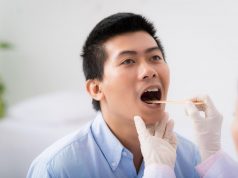The 119th Annual American Academy of Otolaryngology-Head and Neck Surgery Annual Meeting and OTO EXPO
The annual meeting of the American Academy of Otolaryngology-Head and Neck Surgery was held from Sept. 27 to 30 in Dallas and attracted more than 8,000 participants from around the world, including otolaryngologists, medical experts, allied health professionals, and administrators. Presentations focused on the latest advances in the diagnosis and treatment of disorders of the ears, nose, throat, and related structures of the head and neck.
In one study, Tapan D. Patel, M.D., of Rutgers New Jersey Medical School in Newark, and colleagues evaluated the effects of different treatment options for the primary tumor site in patients presenting with distant metastatic head and neck cancer. The investigators used the Surveillance, Epidemiology, and End Results database to identify patients with the diagnosis of M1 squamous cell carcinoma of the head and neck.
The investigators found that patients who received any form of treatment (surgery alone, radiotherapy alone, or surgery with adjuvant radiotherapy) had a statistically significant increase in mean survival and five-year disease-specific survival compared to patients who did not receive these treatment options.
“This study represents the largest cohort of M1 head and neck squamous cell carcinoma cases analyzing the utility of surgery and/or radiotherapy over no treatment. Our results show that patients with distant metastatic head and neck squamous cell carcinoma should consider receiving surgery and/or radiotherapy if they can tolerate the therapy, as these treatment modalities prolong mean survival and improve the five-year disease-specific survival,” Patel said. “Patients receiving multi-modality treatment consisting of surgery and adjuvant radiotherapy had the greatest increase in survival compared to patients not receiving these treatments.”
In another study, Anthony A. Prince, M.D., and Neil Bhattacharyya, M.D., of Brigham and Women’s Hospital in Boston, found that adverse events involving balloon dilation of the sinuses are rare, but when they do occur they can be severe and related to the particular sinus dilated.
“The importance of this study is that complications involving balloon dilation of the sinuses vary according to the particular sinus dilated. This information will hopefully aid surgeons in better selecting candidates who might best benefit from the procedure,” Prince said. “Future studies will need to understand the overall rate of complications associated with the procedure, why these complications occur, and methods to prevent them.”
Peter S. Vosler, M.D., Ph.D., of the University of Pittsburgh, and colleagues, provided insight into variability in which patients with severe nosebleeds (posterior epistaxis) are treated. The options are posterior packing, embolization with interventional radiology, and sphenopalatine artery (SPA) ligation in the operating room.
According to Vosler, SPA ligation has a high success rate (approximately 98 percent) and takes only half an hour to one hour to perform. Embolization is approximately 85 percent effective, but has the potential complication of embolism with blindness or stroke. Packing is the least effective (60 percent), is more uncomfortable, and results in longer hospital stays.
“Our study is a quality improvement measure to improve outcomes, decrease hospital stay, decrease patient discomfort, and reduce overall cost of care,” Vosler said. “Implementation of our clinical care pathway with early SPA ligation decreased the length of packing (3.17 to 1.43 days), hospital stay (5.16 to 2.06 days), and cost of care ($15,065 to $5,469; 64 percent reduction in cost after implementing the clinical care pathway).”
Rachel Roditi, M.D., of Brigham and Women’s Hospital in Boston, and colleagues evaluated national data collected after the onset of newborn hearing screening and found that parents’ perception of hearing loss was associated with grade repetition.
“Further study is needed to better evaluate the correlation between parents’ perception of hearing loss and audiometric testing,” Roditi said. “As repetition rates were highest amongst grade school children, those who are repeating a grade or are at risk for repeating a grade should be offered more objective, comprehensive hearing screening at that time.”
Cranial Nerve Stimulation Shows Promise As Sleep Apnea Tx
TUESDAY, Sept. 29, 2015 (HealthDay News) — An implanted cranial nerve stimulation device might improve sleep patterns and quality of life for patients with obstructive sleep apnea (OSA), according to findings presented this week at the annual meeting of the American Academy of Otolaryngology-Head & Neck Surgery, held from Sept. 27 to 30 in Dallas.
Copyright © 2015 HealthDay. All rights reserved.







